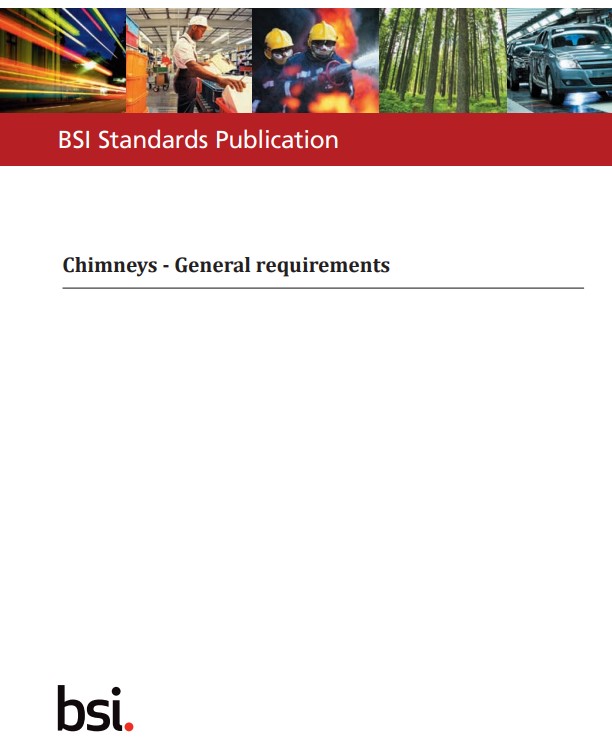BS EN 1443:2019

|
Contents |
[edit] Introduction
The British Standards Institution (BSI) is the UK National Standards Body (NSB). It publishes standards and provides a range of books, self-assessment tools, conferences and training services. It also represents UK economic and social interests in European and international standards organisations.
BS EN 1443:2019 Chimneys - General requirements is the BSI classification that specifies requirements and the basic performance criteria for chimneys, flue liners, connecting flue pipes, components and accessories used to convey the products of combustion from combustion appliances to the outside atmosphere. This document is to be used as a reference for all product standards of CEN/TC 166.
The standard is available from the BSI website.
[edit] Standards for chimneys
The standard specifies sootfire resistant chimneys, flue liners, connecting flue pipes, fittings and accessories for combustion appliances burning solid, liquid and gaseous fuels and non-sootfire resistant chimneys, flue liners, connecting flue pipes, components and accessories for combustion appliances burning liquid and gaseous fuels only. It also specifies sootfire safe accessories for combustion appliances burning solid, liquid and gaseous fuels.
In addition to specifications, the standard examines product characteristics by six different classes (temperature, pressure, condensate resistance, corrosion resistance, sootfire resistance and distance to combustible material), reactions to different types of fire and so on.
It identifies minimum requirements for marking, instructions and product information. It also provides guidance for the assessment and verification of constancy of performance (AVCP) along with testing and sampling methods.
[edit] Primary changes from 2003 to 2019
BS EN 1443:2019 supersedes BS EN 1443:2003, which has been withdrawn. The most significant changes in the 2019 edition are associated with the technical development of combustion appliances including chimneys. These have come about in recent years due to energy saving and environmental protection measures. Therefore, additional requirements for chimneys (such as operation with positive pressure or operation with the formation of condensate) have become necessary.
Chimneys consist of different components which can be assembled in several different ways:
- System chimneys. These are installed using a combination of compatible chimney components that are obtained or specified as a kit from one manufacturing source with product responsibility for the whole chimney.
- Custom-built chimneys. These are installed or built on-site in accordance with a design document or local building regulations using a combination of compatible chimney components that can be from one or more sources.
The 2019 version of the standard covers both cases.
While BS EN 1443:2019 has been published, the related harmonised product standards for different chimney types are still being finalised. This means that testing with the new structure types is not yet a requirement for CE marking (or the UKCA mark). However, some manufacturers are already looking to carry out testing on their existing products to the enhanced requirements and listing the data on a voluntary basis.
[edit] Related articles on Designing Buildings Wiki
- British Standards Institution BSI.
- Chimney definition.
- Flue definition.
- Flue insulation and air tightness requirements.
- Types of chimneys.
[edit] External resources
- BSI, BS EN 1443:2019.
Featured articles and news
RTPI leader to become new CIOB Chief Executive Officer
Dr Victoria Hills MRTPI, FICE to take over after Caroline Gumble’s departure.
Social and affordable housing, a long term plan for delivery
The “Delivering a Decade of Renewal for Social and Affordable Housing” strategy sets out future path.
A change to adoptive architecture
Effects of global weather warming on architectural detailing, material choice and human interaction.
The proposed publicly owned and backed subsidiary of Homes England, to facilitate new homes.
How big is the problem and what can we do to mitigate the effects?
Overheating guidance and tools for building designers
A number of cool guides to help with the heat.
The UK's Modern Industrial Strategy: A 10 year plan
Previous consultation criticism, current key elements and general support with some persisting reservations.
Building Safety Regulator reforms
New roles, new staff and a new fast track service pave the way for a single construction regulator.
Architectural Technologist CPDs and Communications
CIAT CPD… and how you can do it!
Cooling centres and cool spaces
Managing extreme heat in cities by directing the public to places for heat stress relief and water sources.
Winter gardens: A brief history and warm variations
Extending the season with glass in different forms and terms.
Restoring Great Yarmouth's Winter Gardens
Transforming one of the least sustainable constructions imaginable.
Construction Skills Mission Board launch sector drive
Newly formed government and industry collaboration set strategy for recruiting an additional 100,000 construction workers a year.
New Architects Code comes into effect in September 2025
ARB Architects Code of Conduct and Practice available with ongoing consultation regarding guidance.
Welsh Skills Body (Medr) launches ambitious plan
The new skills body brings together funding and regulation of tertiary education and research for the devolved nation.
Paul Gandy FCIOB announced as next CIOB President
Former Tilbury Douglas CEO takes helm.
UK Infrastructure: A 10 Year Strategy. In brief with reactions
With the National Infrastructure and Service Transformation Authority (NISTA).






















